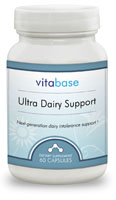| |
Lactose |
|
| Lactose is a disaccharide of milk which on hydrolysis yields glucose and galactose. Lactose is the sugar making up around 2-8% of the solids in milk. The name comes from the Latin word for milk, plus the -ose ending used to name sugars. Lactose is a disaccharide consisting of two subunits, a galactose and a glucose linked together. Lactose has the same empirical formula (C12H22O11) as sucrose (cane sugar) and maltose but differs from both in structure. Lactose is formed in the mammary glands of all lactating animals and is present in their milk. It is produced commercially as a byproduct of milk processing. Lactose is a unique carbohydrate found in the milk of mammals. This disaccharide requires breakdown into glucose and galactose before it can be absorbed. Lactose is broken down in digestive system by the help of an enzyme protein called lactase. It yields the simple sugars d-glucose and d-galactose on hydrolysis. |
| |
Lactose intolerance |
|
|
Lactose intolerance is the inability to digest significant amounts of lactose, or milk sugar, resulting from a shortage of the enzyme lactase, which is normally produced by the cells that line the small intestine. Lactose is a disaccharide that must be split into two monosaccharides to be used by the body. This operation occurs in the small intestine under the influence of an enzyme called lactase. Most individuals produce sufficient quantities of lactase at birth and during early childhood to digest the lactose in milk. With lactose intolerance, the result of consuming lactose or a lactose-containing food is excess gas production and often diarrhea. This inability results from a shortage of the enzyme lactase, which is normally produced by the cells that line the small intestine. Lactase breaks down the lactose, milk sugar, into glucose and galactose that can then be absorbed into the bloodstream. Digestive diseases or injuries to the small intestine can reduce the amount of enzymes produced, and is the usual cause of lactose intolerance in young children. Adults with lactose intolerance cannot break down lactose (milk sugar) into glucose and galactose for absorption by the intestine. Many adults who have primary lactose intolerance can drink 100 mL –200 mL of milk without having symptoms. Yogurt has lactase activity. Lactase can be added to milk, allowing predigestion of lactose. In the case of total intolerance, use lactase in tablet or liquid form or drink lactose-free milk. |
|
|
|
|
 Lactose intolerance is an uncomfortable condition brought on by the body��s inability to digest milk sugar. This unique product is designed for those with dairy food intolerances. Lactose, proteins and fats are contributors to dairy food intolerances, and Ultra Dairy Support contains the enzymes needed to break down all three of these categories. Lactase breaks down dairy products, lipase breaks down fats and protease breaks down proteins. Click here for more information.
Lactose intolerance is an uncomfortable condition brought on by the body��s inability to digest milk sugar. This unique product is designed for those with dairy food intolerances. Lactose, proteins and fats are contributors to dairy food intolerances, and Ultra Dairy Support contains the enzymes needed to break down all three of these categories. Lactase breaks down dairy products, lipase breaks down fats and protease breaks down proteins. Click here for more information.